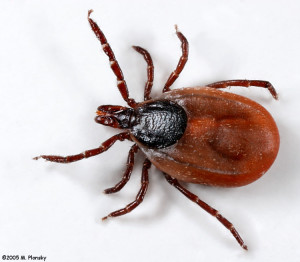 The Deer Tick ( Ixodes scapularis), sometimes called the blacklegged tick, is a hard-bodied tick of the eastern and northern Midwestern United States. The parasitic insect has earned its name for their propensity to feed on white-tailed deer, however, the ticks also feed on other large mammals as hosts, including humans beings. These ticks are brownish in color but may change to rust or brown-red in hue following feeding. After becoming engorged by a blood meal, the body expands substantially.
The Deer Tick ( Ixodes scapularis), sometimes called the blacklegged tick, is a hard-bodied tick of the eastern and northern Midwestern United States. The parasitic insect has earned its name for their propensity to feed on white-tailed deer, however, the ticks also feed on other large mammals as hosts, including humans beings. These ticks are brownish in color but may change to rust or brown-red in hue following feeding. After becoming engorged by a blood meal, the body expands substantially.
Though humans are considered “accidental hosts” for the insect, the deer tick does pose a unique danger to humans - specifically, humans are potentially at risk of developing Lyme disease from the tick’s bite. Lyme disease is a debilitating disease caused by the bacterium Borrelia burgdorferi. Deer ticks are the most common vectors of the bacterium. Untreated, the disease can cause a number of health problems and sometimes death.
Deer ticks are not fast moving insects and do not jump or fly. Instead, they remain in grassy areas frequented by dogs, cats and other hosts. As a potential host brushes against the grass, the deer tick latches on to the coat of the passing animal and with what is generally a painless bite, they begin to feed. The ticks tend to move from host to host for each new meal resulting in the potential for spreading Lyme disease quickly throughout a population.
What Are the Symptoms of Lyme Disease?
According to the New York State Department of Health, the early symptoms of Lyme disease may be mild and easily missed. If you find a tick attached to your skin, remove the tick with tweezers (see tick removal instructions on page 6), and watch for the symptoms of Lyme disease. In 60-80% of cases the first symptom is a rash, known as erythema migrans, that:
- Occurs at or near the site of the tick bite.
- Is a “bulls-eye” circular patch or solid red patch that grows larger.
- Appears between three days and one month after the tick bite.
- Has a diameter of two to six inches.
- Lasts for about three to five weeks.
- May or may not be warm to the touch.
- Is usually not painful or itchy.
- Sometimes leads to multiple rashes.
The New York State Department of health further advises: If you think you have Lyme disease, you should see your health care provider immediately. Early diagnosis of Lyme disease should be made on the basis of symptoms and history of possible exposure to ticks. Blood tests may give false negative results if performed in the first month after the tick bite.
What Can You Do To Avoid Deer Ticks and Lyme Disease?
The Centers for Disease Control (CDC) recommends the following for avoiding deer ticks and Lyme disease:
Reduce your chances of getting a tickborne disease by using repellents, checking for ticks, and showering after being outdoors. If you have a tick bite followed by a fever or rash, seek medical attention.
Before You Go Outdoors
- Know where to expect ticks. Ticks live in moist and humid environments, particularly in or near wooded or grassy areas. You may come into contact with ticks during outdoor activities around your home or when walking through leaf litter or near shrubs. Always walk in the center of trails in order to avoid contact with ticks.
- Products containing permethrin kill ticks. Permethrin can be used to treat boots, clothing and camping gear and remain protective through several washings.
- Use a repellent with DEET on skin. Repellents containing 20% or more DEET (N, N-diethyl-m-toluamide) can protect up to several hours. Always follow product instructions. Parents should apply this product to their children, avoiding the hands, eyes, and mouth. For detailed information about using DEET on children, see recommendations from the American Academy of Pediatrics.
Additionally, you may wish to keep deer away from your property and thus reduce the risk of deer ticks being nearby where you pets or family will come in contact with them. Using a deer repellent product like Shake-Away Deer Repellent near the areas where deer may access your yard is an effective way to keep deer away.







